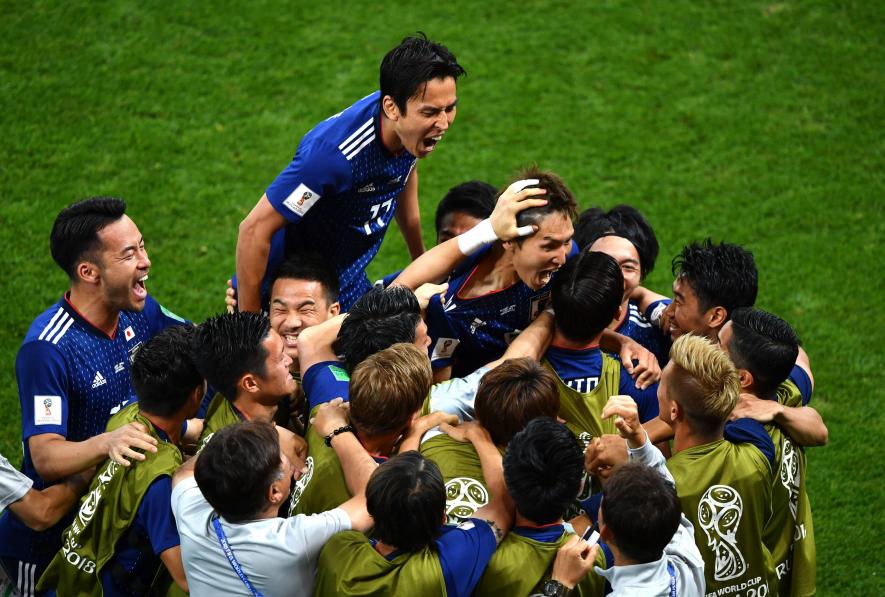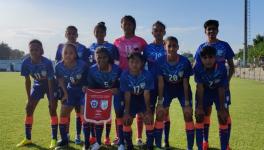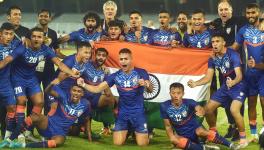In Japan’s Spirited World Cup Show, a Lesson for Other Asian Teams

Japan football team players celebrate Genki Haraguchi's goal against Belgium during their 2018 FIFA World Cup round of 16 match on July 2 (Pix: IANS).
When the FIFA World Cup entered its current phase, the first knockout round, Japan were the only team from the confederation representing over 75 percent of the world’s population. As of July 3, with Japan and Mexico eliminated, the World Cup is now between teams from Europe and South America.
This little piece of demographic trivia leads to a flood of questions. Mohammad Salah may be one of the best players in the world today, but has anything changed for the better in African football since George Weah won the Ballon d'Or back in 1995? Was the success of South Korea at the 2002 World Cup just because of familiar, home conditions or can Asian teams compete in Europe? Why does Japan, with a strong league structure, thriving economy and sizeable population, not play at a higher level?
Also Read: World Cup: Lukaku, Mbappe and the Colonial Ghosts Within Belgium and France
In defeat to Belgium at the Rostov Arena, Japan appeared to provide some answers, from an Asian perspective. From the opening game, against Colombia on June 19, Japan displayed both the conviction and the class to top its preliminary group at the World Cup. What became apparent very quickly was that this was not a team that considered itself inferior to its opposition. Instead it was one willing to examine the specific strengths of the opposition, and to make adjustments accordingly, but continue to play its preferred style of football.
Two month before the world cup the Japanese football association sacked national coach Vahid Halilhodzic from the job he’d held for three years. In what it termed an “emergency”, veteran Japanese coach Akira Nishino was named as his replacement.
The Asahi Shimbun’s Vox Populi column provided this insight from an experienced headhunter in Japan. “In terms of the Japanese concept of shin-gi-tai--the mind, technique and body--the most important element is the technique for someone like Halilhodzic who has led soccer powerhouses abroad. And he definitely delivered on the 'technique' by winning the World Cup preliminaries. But he was fired for the 'mind' element of 'his relationship of trust with his team,” the column reads.
Nishino has tremendous respect in Japan and was brought in to manage the mental wellbeing of his squad as much as its gameplan.
Also Read: No Indian Football Team at Asian Games; Blame Babus in IOA, AIFF
About this, Nishino was clear. “We were aggressive in the first game,” he said after the 2-2 draw with Senegal. “But we wanted to be even more aggressive here and secure qualification by winning our first two games. That was my top target. We have not done this but we played very well.” When asked if the results had been a vindication of the Japanese style of football, he agreed emphatically.
Since Nishino had only been in charge of the team briefly, he used the final friendlies before the World Cup to help them revert to a style of play that the Franco-Bosnian Halilhodzic had abandoned. Nishino is of the opinion that Japanese players have the ability and the understanding to deal with the physicality of “bigger” opponents. His emphasis is on positioning and shape, from a coaching perspective.
Once these elements are taken care of, the players will automatically be able to play an aggressive attacking game. In the case of stronger opposition, this might mean defending for longer periods of the game, but being all the more aggressive when counterattacking. Against Senegal, for example, Nishino said he knew his players could not match the pace and power.
So he drilled the team’s positional play till it was down to clockwork. Then he told them to practise putting low balls into the box instead of attempting aerial crosses against a bigger team. “Because of all this we were running better than the Senegalese towards the end of the game. We went down twice, but were able to come back both times. It was a very good game,” he said.
It was, perhaps, the perfect storm as far as Japan were concerned. The urgency of Nishino’s appointment seems to have galvanised the setup—player, staff, coaches, fans. It also didn’t hurt to have an extremely talented and experienced group of players.
Also Read: FIFA World Cup: The Life in Sudden Death
Seven players in the squad had more than 50 caps. Yuto Nagamato, captain Makoto Hasebe and Shine Okazaki have played 339 internationals between them. At club level, several are playing at the highest level in Europe—a reality no other Asian nation can match. Throughout the tournament, even in the eventual defeat to Belgium, Japan retained its central philosophy of playing organised football in defensive, and quick, flowing, passing football in attack. It was clear that several of their opponents were rattled by the level of commitment and desire shown by the Japanese. Roberto Martinez’s substitutions worked out in the end, but it was a pretty close shave.
Nishino—a Japanese coach in charge of a squad with a Japanese style of play and a unique cultural identity—was successful in demonstrating an Asian team’s ability to compete with the best in the world without employing a European coach or European tactics. Lower-rung nations such as China, Indonesia and even India—with a tremendous potential economic power over the football industry—should take this reality into consideration.
Developing a unique style, a set of inherent values based on the social and cultural context from which the players come, is what makes fans fall in love with teams. This is why clubs that may not win trophies for several years manage to retain massive support from their community of supporters. If the plan is to, one day, land up on the same stage as the nations we are currently watching on TV, developing an Indian style of football needs to be the first order of the day.
Get the latest reports & analysis with people's perspective on Protests, movements & deep analytical videos, discussions of the current affairs in your Telegram app. Subscribe to NewsClick's Telegram channel & get Real-Time updates on stories, as they get published on our website.
























